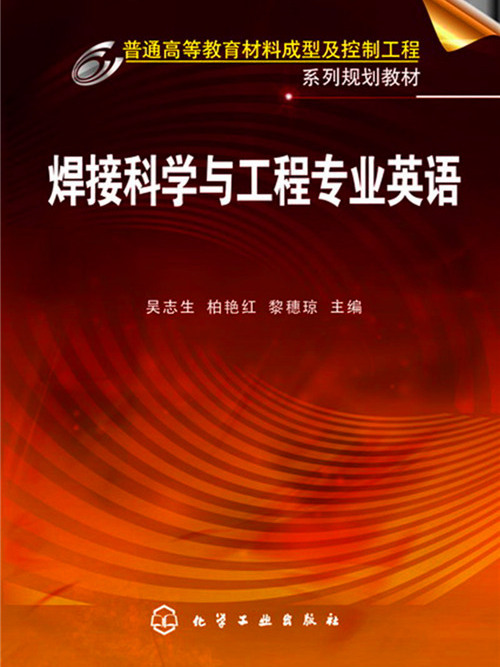《焊接科學與工程專業英語》是2013年4月化學工業出版社出版的圖書,作者是吳志生。
基本介紹
- 書名:焊接科學與工程專業英語
- 作者:吳志生
- ISBN:9787122154583
- 定價:48元
- 出版社:化學工業出版社
- 出版時間:2013年4月
- 裝幀:平裝
- 開本:16開
內容簡介,圖書目錄,
內容簡介
《普通高等教育材料成型及控制工程系列規劃教材:焊接科學與工程專業英語》主要介紹焊接技*與工程專業的基礎知識和專業知識英語文獻。《普通高等教育材料成型及控制工程系列規劃教材:焊接科學與工程專業英語》內容大部分選自國外原版教材,教材共分九章,內容包括焊接技*與工程專業知識的諸多方面的英語文獻。內容涉及現代工程結構材料、金屬材料的力學性能及熱物理性能、鋼的熱處理、電弧物理等焊接技*基礎知識,以及弧焊電源、焊接方法及設備、焊接冶金學、焊接工藝、焊接應力與變形、焊接自動化及焊接質量檢驗等焊接專業知識。
《普通高等教育材料成型及控制工程系列規劃教材:焊接科學與工程專業英語》為高等院校焊接專業學生專用教材,也可以供從事焊接技*與工程領域工作的工程技*人員參考。
圖書目錄
Chapter 1Welding Technology
Fundamental1
1·1Modern Engineering Structural Material1
1·2Mechanical Property of Metal Material3
1·3Thermophysical Property of Metal
Material4
1·3·1Specific Heat4
1·3·2Thermal Expansion5
1·3·3Thermal Conductivity5
1·3·4Melting Point or Melting Range5
1·3·5Thermionic Work Function6
1·4Principal Types of Heat Treatment of
Steel6
1·5Arc Physics6
1·5·1Stability of Electric Arc6
1·5·2Stability of AC Arc 8
Chapter 2Arc Welding Power
Source16
2·1Classification of Power Source16
2·1·1AC Power Supplies16
2·1·2DC power supplies19
2·1·3Inverse Source of Arc Welding20
2·2Electrical Characteristics of Power
Source21
2·2·1Constant Voltage21
2·2·2Constant Current21
2·2·3Combined ConstantCurrent and
ConstantVoltage Characteristics22
2·3Selecting and Specifying a Power
Source22
Chapter 3Arc Welding Process25
3·1Shielded MetalArc Welding25
3·2Gas ShieldedArc Welding27
3·2·1Specific Advantages of Gasshielded
Arc28
3·2·2Types of GasShielded Arc
Processes28
3·2·3Gas Tungsten ArcTig28
3·2·4Gas Metal ArcMig31
3·2·5CO2 Welding34
3·2·6Pulsed Arc Welding35
3·3Submerged Arc Welding Fundamentals of
the process36
3·3·1Definition and general description36
3·3·2Principles of operation37
3·4Plasma Arc Welding38
3·4·1Keyhole Action39
3·4·2Arc Shaping39
3·4·3Operating Data39
3·4·4Applications40
3·4·5Summary40
Chapter 4Other Welding Methods41
4·1Resistance Welding41
4·1·1Introduction41
4·1·2Resistance Spot Welding(RSW)42
4·1·3Projection Welding44
4·1·4Resistance Seam Welding
(RSEW)45
4·1·5Upset Butt Welding 46
4·1·6Flash Butt Welding47
4·2Friction Stir Welding49
4·2·1Introduction49
4·2·2Principles50
4·2·3Friction Stir Tool51
4·2·4Friction Stirring Imperfections55
4·3Laser Beam Welding56
4·3·1Introduction56
4·3·2Principles58
4·3·3Metals Welded60
4·3·4Machines60
4·3·5Parameters and Technology62
4·4Electron Beam Welding63
4·4·1Introduction63
4·4·2Principles64
4·4·3Variations66
4·4·4Equipment67
4·4·5Safety68
Chapter 5Welding Metallurgy69
5·1Chemical Reactions in Welding69
5·1·1Overview69
5·1·2GasMetal Reactions70
5·1·3SlagMetal Reactions 79
5·2Weld Metal Solidification85
5·2·1Epitaxial Growth at Fusion
Boundary85
5·2·2Nonepitaxial Growth at Fusion
Boundary86
5·2·3Competitive Growth in Bulk
Fusion Zone87
5·2·4Effect of Welding Parameters on
Grain Structure88
5·2·5Weld Metal Nucleation
Mechanisms89
5·2·6Grain Structure Control94
5·3The Microstructure and Properties
of Heataffected Zone97
5·3·1Welding Thermal Cycle98
5·3·2The Microstructure Changes
in the HAZ98
5·3·3Hardness Distribution in the
HAZ101
5·3·4Welding Cracks in the HAZ105
Chapter 6Weldability of Material109
6·1Weldability of Material and Testing
Method109
6·1·1Weldability of Material109
6·1·2Weldability Evaluation and Test
Method112
6·2Weldability of low carbon steel114
6·2·1Metallurgy of the liquid weld
metal114
6·2·2Solidification and solidification
cracking119
6·2·3Stress intensification,embrittlement
and cracking of fusion welds below
the solidus121
6·2·4Lamellar tearing124
6·2·5Reheat Cracking125
6·3Weldability of Magnesium and Its Alloys128
6·3·1Alloys and Welding Procedures128
6·3·2Oxide Film Removal128
6·3·3Cracking128
6·3·4Mechanical Properties129
6·3·5Corrosion Resistance and Fire
Risk129
Chapter 7Residual Stresses,Distortion
and Fatigue130
7·1Residual stresses130
7·1·1Development of residual stresses130
7·1·2Analysis of Residual Stresses131
7·2Distortion133
7·2·1Cause133
7·2·2Remedies133
7·3Fatigue134
7·3·1Mechanism134
7·3·2Fractography135
7·3·3SN Curves135
7·3·4Effect of Joint Geometry135
7·3·5Effect of Stress Raisers136
7·3·6Effect of Corrosion137
7·3·7Remedies137
7·4Case Studies138
7·4·1Failure of a Steel Pipe Assembly138
7·4·2Failure of a Ball Mill138
Chapter 8Automation of Welding140
8·1Introduction of Automatic Welding
System140
8·2Flexible Automation of Welding143
8·3ARC Welding Robots145
8·3·1Introduction145
8·3·2Robot Manipulator Configuration147
8·3·3Robot Welding Application151
8·3·4Buying a Welding Robot154
8·3·5Robot Safety154
8·4Controls for Automatic Arc Welding156
8·4·1Automatic Welding Controllers156
8·4·2Robot Controllers159
8·4·3Teaching the Robot159
8·4·4Robot Memory161
8·4·5Weld Execution161
8·5Sensors and Adaptive Control162
8·5·1Introduction162
8·5·2Contact Sensors164
8·5·3Noncontact Sensor Systems165
8·6Tooling and Fixtures168
Chapter 9Welding Quality Inspection171
9·1Welding Defects171
9·1·1Definition and Types171
9·1·2Cracks171
9·1·3Porosity172
9·1·4Solid Inclusion172
9·1·5Lack of Fusion and Inadequate or
incomplete penetration173
9·1·6Imperfect Shape173
9·2Nondestructive Testing174
9·2·1Radiographic Testing174
9·2·2Ultrasonic Testing(UT)177
9·2·3Magnetic Particle Inspection(MPI)178
9·2·4Liquid Penetrant Testing(PT)179
9·3Destructive Test182
9·3·1Tension Tests182
9·3·2Bend Tests182
9·3·3Charpy Tests183
9·3·4Hardness Testing183
9·4Radiograph Interpretation184
9·4·1General Welding Discontinuities184
9·4·2Other Discontinuities188
References190

